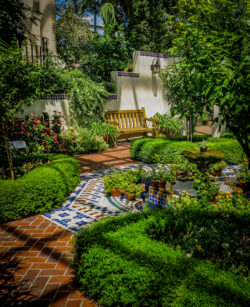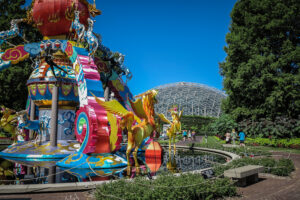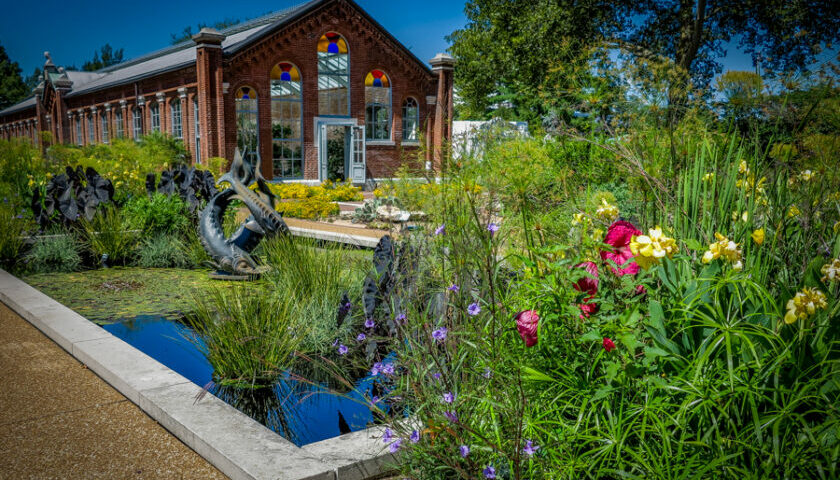While St. Louis is home to the Gateway Arch, Anheuser-Busch brewery and the start of the Lewis and Clark Expedition is also home to one of the oldest botanical institutions in the United States, the Missouri Botanical Garden.

The Missouri Botanical Garden informally known as Shaw’s Garden for founder and philanthropist Henry Shaw was founded in 1859 and is the second-largest in North America, behind the New York Botanical Garden in New York City. The Garden is only 5 miles from the Gateway Arch about a fifteen-minute drive through the city of St. Louis. The Missouri Botanical Garden is located in a heavily residential area on a 79-acre oasis in the middle of St. Louis adjacent to Tower Grove Park, another of Henry Shaw’s legacies. The Botanical Garden is a National Historic Landmark and is also listed in the National Register of Historic Places. Some of the highlights of the Missouri Botanical Garden are:
Seiwa-en Japanese Garden
A 14-acre strolling garden with lawns and path set around a central lake. It was designed by Koichi Kawana and is the largest Japanese Garden in North America.
Doris I. Schnuck Children’s Garden
It is a wonderful area for families to discover, explore, and pretend which include a pioneer village with an old-fashioned general store and Mississippi riverboat, a playground to expend some youthful energy. Also, a treehouse to climb and a bridge to bounce across. There are also water features such as the lock system where children can operate a series of locks to regulate the water flow in the Children’s Garden River and splash pad that gets turned on when the temperature hits 70 degrees to help keep children and their families cool.

Tower Grove House
The Botanical Garden’s founder Henry Shaw’s original 1849 victorian country estate home and herb garden is located in the Lichtenstein Victorian District within the Botanical Garden. Designed by English-born architect and friend, George I. Barnett in the Italianate style. The house is open to tour so that you can see the home’s 19th-century moldings and ornate woodwork unique to the original structure, furniture and materials once belonging to Shaws and others are of the same era.
Linnean House
Built in 1882, it is the oldest continually operated greenhouse west of the Mississippi River. Originally built to overwinter Shaw’s citrus trees, tree ferns, palms and other tender plants that were moved out into his gardens during the summer. The house was converted largely to camellia trees in the late 1930’s; the largest of the trees in the house today most likely date to that period.
Nanjing Friendship Chinese Garden
Designed by award-winning Chinese American architect Yong Pan and dedicated in 1996, the Chinese Garden commemorates the longstanding scientific and cultural exchanges between the Missouri Botanical Garden and Chinese botanical institutions. It also honors the sister-city relationship between St. Louis and Nanjing, China. Major features of the garden were gifts from the city of Nanjing include a moon gate, lotus gate, pavilion, and Chinese scholar’s rocks from Lake Tai in the Yangtze Delta of China.

Climatron
A significant landmark at Missouri Botanical Garden and unique structure, the Climatron greenhouse is a geodesic dome and is the world’s first completely air-conditioned greenhouse and the first geodesic dome to be enclosed in rigid Plexiglass panels. The dome contains a small stone neo-classical pavilion and garden. A bank of 24 floodlights, revolving at night in five-minute cycles, simulates noon light on one side of the dome and moonlight on the other. Containing over 400-varieties of plant life the dome’s climate ranges from the Amazon through Hawaii and Java to India.
A part of the Missouri Botanical Garden that was also fascinating to me was the building that housed the William T. Kemper Center for Home Gardening. The building surround by demonstration gardens filled with scores of ideas for home gardeners had the look and feel reminiscent of the Prairie School; a late 19th- and early 20th-century architectural style. It was an added bonus while visiting the Missouri Botanical Garden to have my architectural interests also engaged as well as that of seeing botanical beauty. While I was there the Missouri Botanical Garden’s international exhibition of larger-than-life Chineses artwork for their Lantern Festival featuring art by day and the magic of their illumination by night. The elaborate outdoor sets crafted of silk and steel celebrate Chinese culture through bold color, dazzling light, and striking design. The first of its kind exhibition outside of Asia started in 2012 has become an annual tradition at the Missouri Botanical Garden. I wish I had time to stay for the night show of all the lantern sculptures and gardens lit but I will definitely return for that visual treat.
![]() Missouri Botanical Garden
Missouri Botanical Garden![]() 4344 Shaw Boulevard
4344 Shaw Boulevard ![]() St. Louis, Missouri 63110
St. Louis, Missouri 63110![]() N 38° 36′ 45.3″ W 90° 15′ 31.1″
N 38° 36′ 45.3″ W 90° 15′ 31.1″


